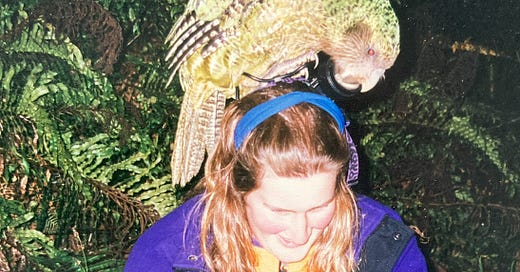Vanishing giants
Close encounters with some of New Zealand’s endangered species (5 minute preview, 10 minute read)
Although I’ve trained myself to get up early, I’ve never been a morning person. Over the years, I’ve had many different alarm clocks – often using two for extra reassurance that I’d make it out of bed in time for work. I gave up having an alarm clock next to my bed long ago, because it’s too easy to switch it off and go back into a deep sleep without properly waking up. My alarm goes off on the far side of my bedroom, forcing me to get out of bed to make it stop.
On Maud Island, or Te Hoiere, however, the alarm was unique. I can remember lying warm in my sleeping bag and being woken by a series of loud shrieks outside the window. There was no way I could sleep in with that racket going on. On the first morning, I’m not sure I knew what I was hearing, but I soon learned. My morning wake-up call was provided by a bird which was once believed extinct, the takahē.
In fact, the takahē was thought to be extinct not once, but twice. Māori recognised two different types of the bird – moho, from the North Island and takahē from the South. However, Europeans knew them only from fossil bones collected in Taranaki in the 1840s by Walter Mantell, and assumed they were extinct. Then, a couple of years later, sealers found, and ate, a large bird in Dusky Sound, Fiordland. By extraordinary coincidence, Mantell was also in Dusky Sound and came across the sealers enjoying their dinner, which was apparently delicious. He recognised the similarity with the bones he’d found in Taranaki and acquired the remnants of their meal.
Three more specimens of the bird were found, and killed, in Fiordland over the next few decades, the last in 1898. Although there were claimed sightings, no bird was caught, and the takahē was presumed extinct until Geoffrey Orbell rediscovered it in 1948. But the takahē was still in serious trouble. There were only a few hundred birds, and the numbers were declining.
The takahē was saved by a combination of captive rearing and transfer to island sanctuaries such as Maud Island. It’s still endangered today, but there are now around 500. More importantly, there are takahē around the country. Half are in remote mountain areas such as the Murchison Mountains where they were rediscovered by Orbell. The remainder live either on islands such as Maud Island, in fenced sanctuaries such as Zealandia, or in captivity.
Maud Island sits right in the centre of the maze of submerged river valleys which make up Pelorous Sound in Marlborough. It covers around 320 hectares, which is slightly smaller than the total area of Khandallah, the suburb where I live. This is still a decent size for an island reserve – bigger than Mana Island off the Wellington coast or Tiritiri Matangi near Auckland. It does, however, have one serious drawback. It’s less than a kilometre from the mainland, which is well within the distance that a rat or a stoat can swim. When I was there, in the late 1990s and early 2000s, checking traps and tracking tunnels was a time-consuming but essential job for the island’s rangers.
Almost all of Maud Island’s original forest cover was destroyed during many centuries of cultivation. Māori had extensive gardens on the island, and it was later farmed by Europeans. Only a tiny fragment of forest remained. The island might have remained a farm, but in the early 1970s it drew the attention of scientists from the New Zealand wildlife service. Could it, they wondered, help them save a gravely endangered bird?
This bird wasn’t the takahē, but another of New Zealand’s flightless giants, the kākāpō. Like the takahē, it was once common but by the early 1970s was believed to survive only in remote parts of Fiordland. Over the previous few decades, only six birds had been found, all males. These birds had been brought into captivity, but all except one died. The kākāpō, if there were any left, needed a new home.
Maud Island was the first island they tried. The male birds that were moved there survived, at least, but without females the species was clearly doomed. Then there was another miracle, almost on the scale of Orbell’s rediscovery of the takahē. In 1977, male kākāpō were heard in a remote part of Rakiura/ Stewart Island. In 1980, female birds were found there. However, the birds were far from safe, with feral cats preying on them.
Kākāpō were moved to three island sanctuaries – Maud Island, Te Hauturu-o-Toi /Little Barrier Island and Whenua Hou, to the west of Rakiura. They didn’t thrive, though. By the time I visited Maud Island, there were only 62 birds.
It took scientists some time to figure out what kākāpō needed to thrive and breed, rather than to simply survive. During the 1970s and 1980s, I was told, they tried introducing all sorts of plants to Maud Island in the hope that they would tempt the kākāpō. On the whole, they didn’t. Just as the kākāpō is perfectly adapted to evading giant predatory eagles, scientists discovered that kākāpō breeding is perfectly adapted to the idiosyncratic rhythms of certain native trees. These trees don’t produce a reliable fruit and seed crop every year. Instead, they have mass fruiting events, known as masts, when all the trees produce abundant fruit. Masts occur every few years, although the exact interval varies.
In southern regions, kākāpō breeding is triggered by the masting of rimu trees. Once this was understood, Maud Island didn’t seem such a good place for kākāpō any more, since it would take decades, perhaps centuries, to establish the kind of forest they thrived in. At the time I visited, there were still kākāpō on the island, but they were being moved to islands with better forest.





